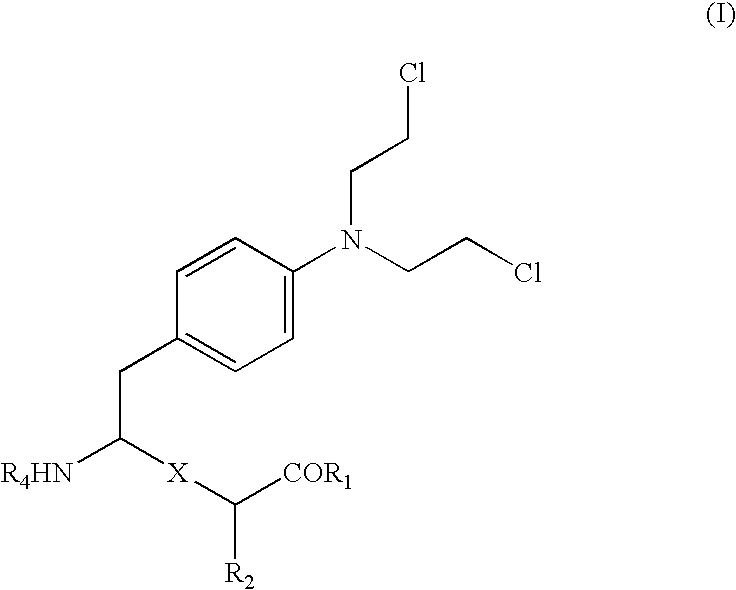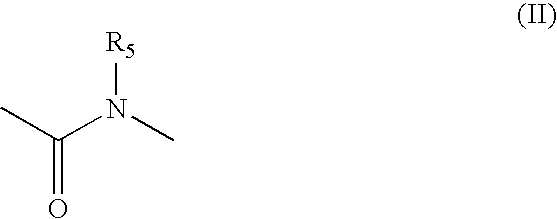Melphalan derivatives and their use as cancer chemotherapeutic drugs
a technology of melphalan and derivatives, which is applied in the direction of tripeptide ingredients, tetrapeptide ingredients, dipeptide ingredients, etc., can solve the problem of unclear how much this increases the effective dose at the tumour cell level
- Summary
- Abstract
- Description
- Claims
- Application Information
AI Technical Summary
Problems solved by technology
Method used
Image
Examples
example 1
L-Melphalanyl-L-p-fluorophenylalanine ethyl ester hydrochloride (J1)
[0057] L-p-Fluorophenylalanine (217 mg, 1.18 mmol) was dissolved in EtOH (5 ml) previously bubbled with HCl. The reaction was brought to 100.degree. C. and was allowed to reflux for 18 hours. The solvent was evaporated off and the product was dried under high vacuum, affording L-p-fluorophenylalanine ethyl ester hydrochloride as dry white crystals (98%). .sup.1H NMR: (CD.sub.3OD) .delta. 7.30-7.26 (m, 2H, Ph-H), 7.13-7.06 (m, 2H, Ph-H), 4.29-4.22 (m, 2H, CH.sub.2-Ph), 3.31-3.10 (m, 3H, CH.sub.2CH.sub.3, .alpha.-H), 1.24 (t, 3H, CH.sub.2CH.sub.3).
[0058] N-tert-Butoxycarbonyl-L-melphalan (157 mg, 0.387 mmol) was dissolved in dichloromethane (4 ml). PyBOP (201 mg, 0.387 mmol) and triethylamine (54 .mu.l, 0.387 mmol) were added and the solution was stirred at room temperature for 1 h. A solution of L-p-fluorophenylalanine ethyl ester hydrochloride (92 mg, 0.387 mmol) and triethylamine (54 .mu.l, 0.387 mmol) in dichlorom...
example 2
L-Prolinyl-L-melphalanyl-L-p-fluorophenylalanine ethyl ester hydrochloride (J3)
[0061] N-tert-Butoxycarbonyl-L-proline (12 mg, 0.054 mmol), L-melphalanyl-L-p-fluorophenylalanine ethyl ester hydrochloride (24 mg, 0.045 mmol), HOBt (8 mg, 0.054 mmol), and NMM (7 .mu.l, 0.045 mmol) were dissolved in dichloromethane (5 ml). The solution was cooled to 0.degree. C. and EDC hydrochloride (11 mg, 0.045 mmol) was added. The solution was stirred for 1 h at 0.degree. C. and then overnight at RT. The reaction mixture was diluted to 10 ml with dichloromethane and the reaction stopped by successive extractions with 10% aqueous citric acid, saturated NaHCO.sub.3 and brine. The organic phase was dried over anhydrous Na.sub.2SO.sub.4 and the solvent evaporated off under reduced pressure to afford 27 mg (86%) N-tert-butoxycarbonyl-L-prolinyl-L-melphalanyl-L-p-flu-orophenylalanine ethyl ester that was used in the next step without further purification.
[0062] .sup.1H NMR (CDCl.sub.3) .delta. 7.08-6.89 (...
example 3
L-Melphalanyl-L-phenylalanine ethyl ester hydrochloride (JV22)
[0065] N-tert-Butoxycarbonyl-L-melphalan (150 mg; 0.37 mmol) was dissolved in 2.6 ml dichloromethane. PyBOP (199 mg; 0.38 mmol) and triethylamine (104 .mu.l; 0.75 mmol) were added. After stirring at RT for 30 minutes a solution of triethylamine (104 .mu.l; 0.75 mmol) and phenylalanine ethyl ester hydrochloride (89 mg; 0.39 mmol) in 2.6 ml dichloromethane was added. After 4 h at RT the reaction was quenched. Dichloromethane was added up to a total volume of 20 ml before extraction with 20 ml saturated aqueous NaHCO.sub.3 and 20 ml 10% citric acid. The organic layer was dried (MgSO.sub.4), filtered and concentrated in vacuo. The crude product was purified by column chromatography on silica using a gradient of ether:pentane (2:1.fwdarw.3:1), followed by ether and thereafter by CHCl.sub.3:MeOH (19:1) as eluents. Collection and concentration of adequate fractions gave pure N-tert-butoxycarbonyl-L-mel-phalanyl-L-phenylalanine e...
PUM
| Property | Measurement | Unit |
|---|---|---|
| Molar density | aaaaa | aaaaa |
| Molar density | aaaaa | aaaaa |
| Molar density | aaaaa | aaaaa |
Abstract
Description
Claims
Application Information
 Login to View More
Login to View More - R&D
- Intellectual Property
- Life Sciences
- Materials
- Tech Scout
- Unparalleled Data Quality
- Higher Quality Content
- 60% Fewer Hallucinations
Browse by: Latest US Patents, China's latest patents, Technical Efficacy Thesaurus, Application Domain, Technology Topic, Popular Technical Reports.
© 2025 PatSnap. All rights reserved.Legal|Privacy policy|Modern Slavery Act Transparency Statement|Sitemap|About US| Contact US: help@patsnap.com



